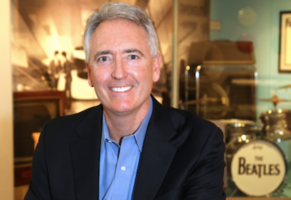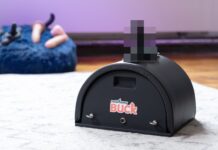
EXCLUSIVE: NAMM CEO Joe Lamond on how the LA show is embracing pro audio like never before
The expo chief also explains why the show has held strong on a trade show landscape in flux
Now in its 117th year, the NAMM show returns to California’s Anaheim Convention Centre from January 25-28 for four days of product launches, networking opportunities, education and training sessions, live music and a whole lot more to boot. And there are big changes afoot, with a substantial new space incorporated specifically to facilitate pro audio exhibits. To find out more, NAMM president and CEO Joe Lamond granted Daniel Gumble an exclusive interview to talk the show’s evolution, what we can expect from this year’s outing and how the annual extravaganza has held strong in a tremulous trade show landscape…
Like any market beholden to technological advancement, the professional audio industry and its various segments can often be found in a state of flux. From live sound and studio to broadcast and installation, digital innovation is changing the game on an ever-more regular basis, be it in the form of immersive audio, product manufacture or production techniques. As such, time-honoured practices are increasingly broken with, while new strategies and a more nimble approach is required. Inevitably, the key factors changing the audio at its core have also trickled down into every nook and cranny of the business. One area in which this has been particularly notable in recent years has been in the marketing and launch of new products and the decision process surrounding how best to bring them to market. And for that reason, the NAMM show occupies a rather unique position.
As pretty much anyone reading this will be aware, the pro audio trade show landscape is currently in the middle of an ongoing state of transition. Over the past few years, manufacturers, suppliers and audio professionals across the board have been assessing and reassessing the state of play. Over the course of its most recent outings, Frankfurt’s annual Prolight+Sound/Musikmesse event has seen its trade credentials called into question on account of some big changes to its focus, which have resulted in, according to some, a gravitation away from business and towards a consumer audience. Organisers of course insist that it is still a bona fide trade show, but the seemingly inexorable rise in popularity of Amsterdam’s ISE and IBC shows have certainly diverted the gaze of some Messe regulars away from Germany and towards the Netherlands. Never before, it seems, has there been such a wealth of options on the trade event calendar.
Which brings us back to NAMM. While its European counterparts continue to fluctuate in their trade appeal, the age-old California crowd-pleaser has provided the industry with a much-needed mainstay. A staple for some 117 years, it continues to steadily grow its audience by appealing to new visitors and exhibitors, while ensuring there is always something on offer to keep its regulars happy. Of course, the allure of its palm tree-lined, sun-bleached environs undoubtedly plays a part in many a European exec’s decision-making process when it comes to plotting their annual trade show commitments, but what NAMM and its organisers really seem to have mastered is striking the right balance between new and old, year-on-year; never staying the same, never trying to reinvent the wheel. For that reason, over 7,000 brands are expected to be on show this year, while 2017’s record-breaking turnout of 101,726 attendees looks set to be topped by the end of its 2018 outing.
So what exactly can the pro audio contingent expect from NAMM 2018? Daniel Gumble caught up with NAMM president and CEO Joe Lamond to find out…
It seems the global pro audio trade show landscape is currently in a state of flux – shows like IBC and ISE are on the up, while question marks continue to loom over Frankfurt. How has NAMM remained such a consistent event over the years?
There certainly has been a lot of change in NAMM’s 117-year history, it is hard to imagine that Thomas Edison had just recently patented the light bulb when we first started! So yes, we have evolved with the times, and in the midst of all this change, we have viewed our role as a member-driven organisation to be a trusted, reliable and predictable platform for our industry to gather. We believe it is the member companies of NAMM who make all the magic happen and we’re grateful for the trust they put in us to produce the NAMM show on their behalf.
The global music and sound products industry is a complicated and inter-related ecosystem. In my case, I’ve been a professional musician, worked music retail, done commercial installations and toured as a production and tour manager. I imagine that there are many industry participants whose careers have evolved over time but the glue that binds us all is our passion for music – and perhaps that’s the one thing that we’ve never forgotten, the importance of the music.
In tying that together, perhaps the most rewarding outcome from the NAMM show, in addition to launching our 10,000 member companies into the New Year, is our Circle of Benefits business model, where trade show revenues are channelled into grants, scholarships, scientific research, new music programmes and lobbying that strengthens music education and creates access for children to learn and grow with music. Our members contribute to these efforts through their show participation and can be proud to know that they are creating life-changing impact through music.
What’s new for this year’s show, particularly on the pro audio front?
Definitely some big changes! The expansion of the Anaheim Convention Center North building has given us the opportunity to invite more pro audio exhibits, and to support the growing buying community by nearly tripling our education offerings. We were fortunate to have the Audio Engineering Society agree to produce their conference at NAMM, and with Audinate’s Dante, ESTA (The Entertainment Services and Technology Association), A3E, and NAMM’s TEC Tracks, it’s an almost dizzying array of professional development opportunities with a simple goal: offer relevant and high value education for our members and attendees. We also understand the importance of networking and peer-to-peer interaction, with award shows like the TEC Awards and the Parnelli Awards, concerts, receptions and the famous hotel lobby bars where important conversations occur and friendships are strengthened. People tell us that some of these moments become lifetime memories, and we’re humbled to have our members feel that the show is their ‘family reunion.’
How difficult is it to strike the balance of pleasing the regulars and keeping things fresh enough to attract new visitors?
Creative, entrepreneurial activity drives our industry, but it needs a stable, reliable platform on which to launch from each year and the NAMM show provides that role. I’ve been coming to NAMM since 1983 and there have been no two shows that were alike; each one is a brand-new experience created by tens of thousands of innovative industry leaders each competing in the marketplace of ideas to build their company’s success.
As far as the education offerings, each year brings a new set of challenges and the courses evolve to provide cutting-edge solutions. Most of the successful people I know have long ago decided to be life-long learners and that’s why coming to NAMM and attending as many sessions as possible is such an integral part of success.
Have you been able to learn anything from the huge growth seen at shows such as ISE and IBC?
We firmly believe that high tides make all ships rise, and where and how we make music continues to evolve. Music – that’s what it’s all about for us and how each facet of the industry is led back to making music and the creative processes behind it, and that’s where our focus is: using the NAMM show as the platform to serve the interests of the industry and to inspire more music makers.
How crucial is it for NAMM to keep abreast of what’s happening in Europe with regards to trade shows?
I suspect that some may see NAMM as a tradeshow but at the core, NAMM is an international organisation, counting members and attendees in 129 countries, with a mission and vision to advancing music making and to support a healthy, vibrant industry. Within our structure, we maintain five objectives: build a successful trade show to enhance the industry; encourage growth in membership by offering tools and resources; offer high-quality professional development designed to enhance and grow; promote and fund music making programmes and opportunities for all people; and convene the industry and engage in issues which impact the industry at-large – add all of these together and you’ll find that the NAMM team is busy year-round, advancing these objectives.
Tell us about the pro audio educational offering at this year’s show?
While new technology and products drive any industry, continuing education and training, and getting better at practising one’s craft, is essential for growth. We have always believed this to be true, and it seems to me that we’re in a very natural cycle of expanding education at the NAMM show to reflect the changing needs of industry members. The vast ecosystem of music and sound depends on a growing number of industry professionals to make it all work, and with that, the opportunity to learn. The NAMM show is the crossroads where this ecosystem intersects. It is an honour and also a responsibility to provide reliable and relevant education to achieve a vision of a more musical world.
Specific to education, AES@NAMM brings a rich legacy in audio education to NAMM U’s offerings. In particular, AES@NAMM will get deep into hands-on and technical education for audio professionals, and in an incredibly broad range of topics. With ESTA, Lighting & Sound America/PLASA, and others, we’re poised to offer event tech professionals the certification, tools and skills needed. TEC Tracks couldn’t have a more exciting line up of free sessions for audio professionals — specifically, legendary Beatles engineer Geoff Emerick is hosting a keynote. Also, A3E, Advanced Audio + Applications Exchange, is holding its first three-day Future of Audio Summit at NAMM, which should be especially fascinating for anyone interested in such future-forward topics as audio for virtual reality, sensor technology, AI and much more.
How vital is a strong educational offering to the future of both NAMM and the wider professional musician/audio community?
We believe that it is an important role for a professional trade organisation like NAMM to deliver world-class events where new products can drive opportunity, education that aids in member success and peer to peer networking that strengthens and inspires industry participants. It’s really a three-legged stool, and all three elements are necessary. Also, I think it’s important to add that the NAMM show offers more free industry education than you can get pretty much anyplace else, which is incredibly exciting.
It seems that the music industry in general is finally starting to see some money filtering back into the business, with streaming now starting to take hold. How much of a knock-on effect does a healthy music business have on our industries?
The turmoil created as the recording industry adapted to streaming and downloading in many ways caused a boon for the live music business, as acts turned to touring to make up for lost revenue. In my opinion, that created a situation similar to the space race of the ‘60s as everyone competed to build bigger and more lavish stages, sound systems, light shows and increasingly add video to their concerts. It also opened the door for thousands of independent artists who were able to use technology to make, record and share their music while touring to build up a following. Our members and the industry responded with creative solutions and we saw the growth and expansion in that area. Looking back on 117 years of NAMM history, it seems like whenever something came along to disrupt the status quo, something else came along to create opportunity. Music is like that, always changing. Thankfully, the one constant is the virtual certainty that music will be a part of the human experience, just as it has been since the dawn of recorded history.
What business trends have you seen throughout 2017? Any particular markets or sectors that have surprised you?
There’s an incredible convergence that’s occurring across music right now. The entertainment experience is diverse, technology-driven and not limited to one sector anymore. Think about the installation for a school auditorium or mixing a track in a bedroom; there’s so much accessibility to incredible technology. Along with that, take pro audio products, live sound and install projects – not something a traditional music retailer would carry or undertake – but such services and products are more and more common at your corner music store, accessible and in-demand as consumers’ expectations of music and performance rise.
What are the biggest opportunities for the NAMM show and the NAMM organisation in general in 2018?
Luckily, we have a very clear vision, mission and set of objectives and a wonderful board of directors that guide our every decision. I imagine staying true to that vision, and always focusing on how we can serve our members and the industry will keep us on track. I am a drummer at heart, so thinking any further than that is probably an exercise without merit!
Source: mi-pro.co.uk













